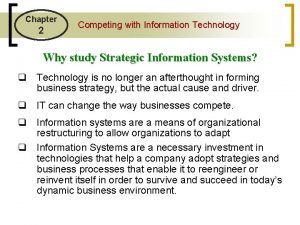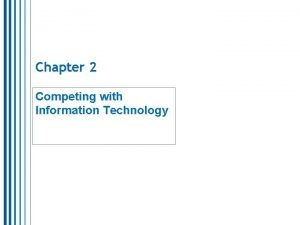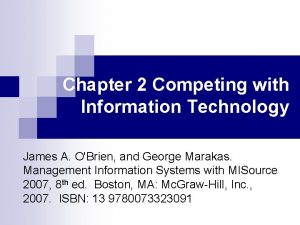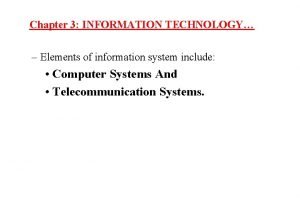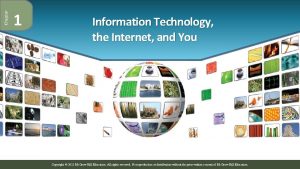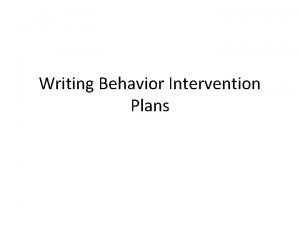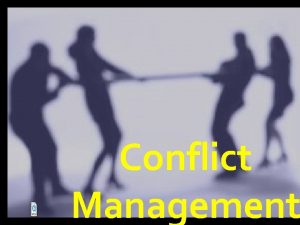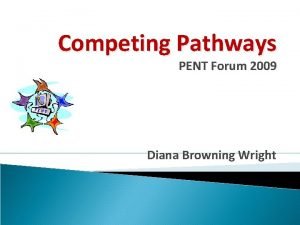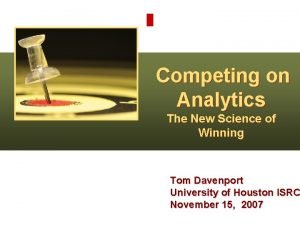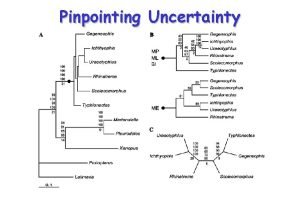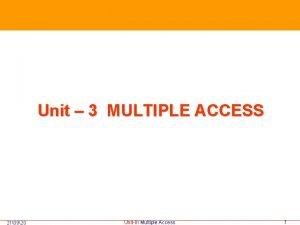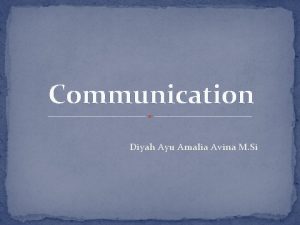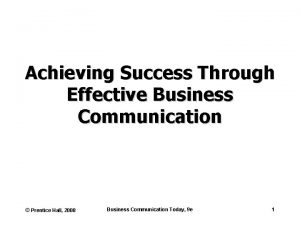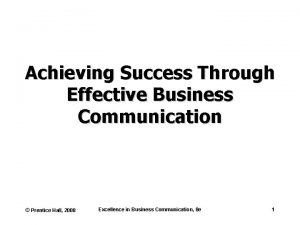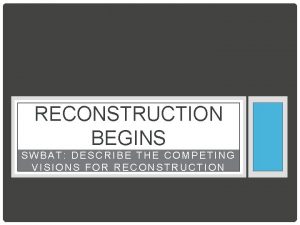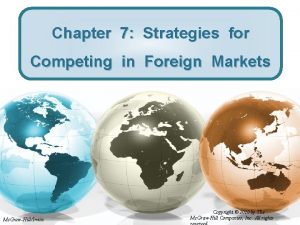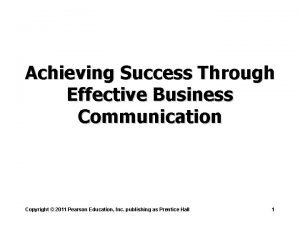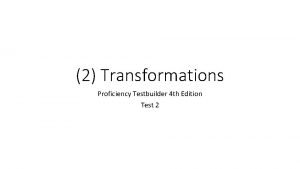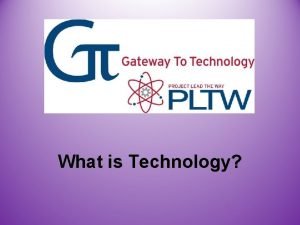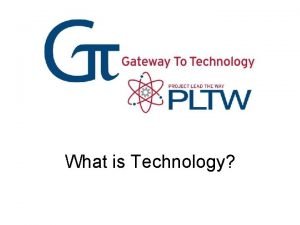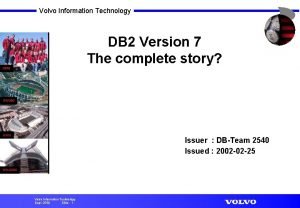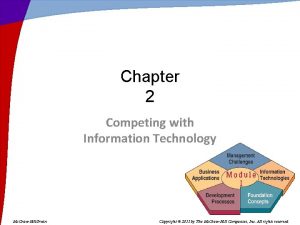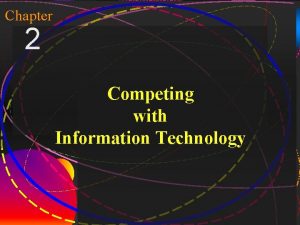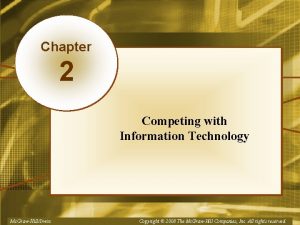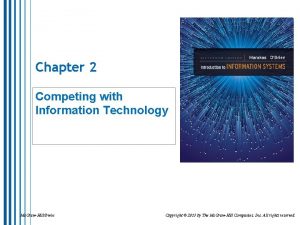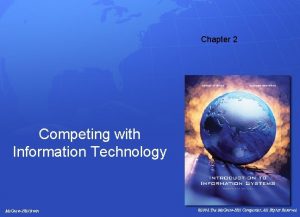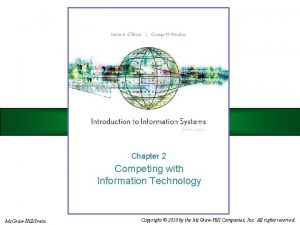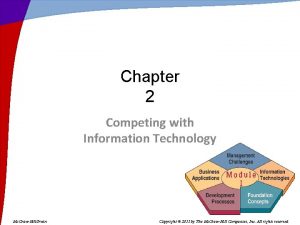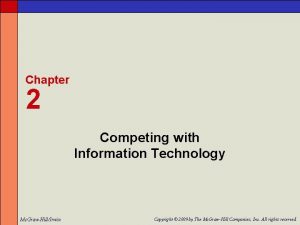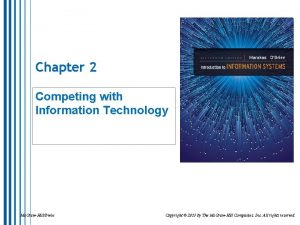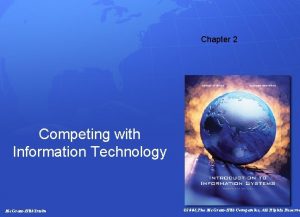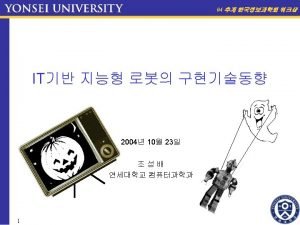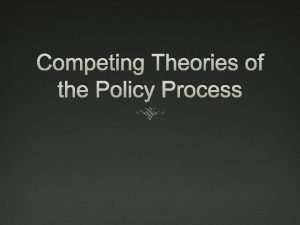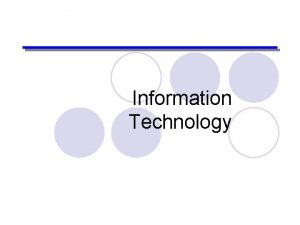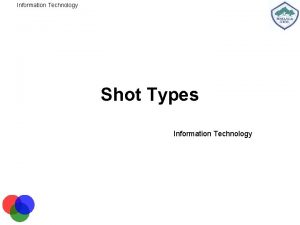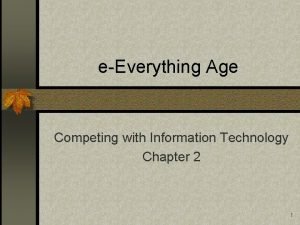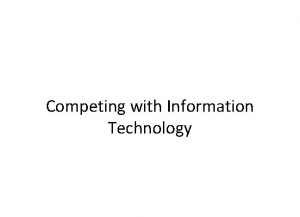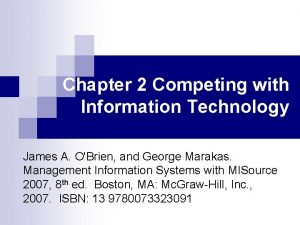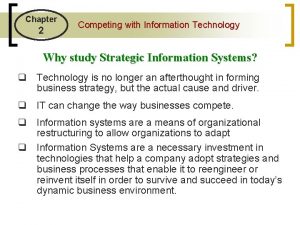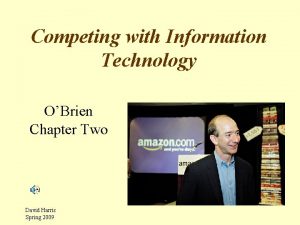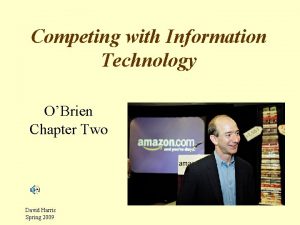Chapter 2 Competing with Information Technology Mc GrawHillIrwin





























- Slides: 29

Chapter 2 Competing with Information Technology 授課老師:台大 管系 楊立偉 Mc. Graw-Hill/Irwin Copyright © 2013 by The Mc. Graw-Hill Companies, Inc. All rights reserved.

Section 1 Fundamentals of Strategic Advantage 2 -2

I. Strategic IT v Technology is now the actual cause and driver of business strategies 以技術帶動企 業策略 v Technology is no longer an afterthought in forming business strategies 2 -3

II. Competitive Strategy Concepts v Strategic Information Architecture – the collection of strategic information systems that shape/support the competitive position/strategies of a firm 2 -4

II. Competitive Strategy Concepts 競爭策略 n 成本 n 差異化 n 創新 n 成長 n 聯盟 n 其它 與之競爭的力量 (五力分析) Mc. Graw-Hill/Irwin Copyright © 2013 by The Mc. Graw-Hill Companies, Inc. All rights reserved.

II. Competitive Strategy Concepts v Competitive Forces (Porter) v Rivalry of Competitors v Threat of New Entrants v Threat of Substitutes v Bargaining Power of Customers v Bargaining Power of Suppliers v Competitive Strategies v Cost Leadership Strategy v Differentiation Strategy v Innovation Strategy v Growth Strategy v Alliance Strategy 2 -6

III. Strategic Uses of Information Technology v Other Strategic Initiatives v Locking by Building Relationships v v v Lock In Customers Lock In Suppliers Lock Out Competitors v Switching Costs – make customers/supplier dependent on mutually beneficial inter-enterprise information systems v Raise Barriers to Entry – discourage or delay other firms from entering a market v Leverage Investment in IT – develop new products and services that are not possible without strong IT capabilities 2 -7

II. Competitive Strategy Concepts Examples Mc. Graw-Hill/Irwin Copyright © 2013 by The Mc. Graw-Hill Companies, Inc. All rights reserved.

II. Competitive Strategy Concepts Examples Mc. Graw-Hill/Irwin Copyright © 2013 by The Mc. Graw-Hill Companies, Inc. All rights reserved.

II. Competitive Strategy Concepts Examples Mc. Graw-Hill/Irwin Copyright © 2013 by The Mc. Graw-Hill Companies, Inc. All rights reserved.

Competitive Advantage and Competitive Necessity v What is Competitive Advantage? v What is the problem with competitive advantage? v What is Competitive Necessity? v What is the relationship between Competitive Advantage and Competitive Necessity? Mc. Graw-Hill/Irwin Copyright © 2013 by The Mc. Graw-Hill Companies, Inc. All rights reserved.

IV. Building A Customer-Focused Business – Strategic Focus on Customer Value 顧客導向 以顧客為中心 Mc. Graw-Hill/Irwin Copyright © 2013 by The Mc. Graw-Hill Companies, Inc. All rights reserved.

IV. Building A Customer-Focused Business – Strategic Focus on Customer Value v Recognizing that Quality, not Price, has become the primary factor in a customer’s perception of value v Internet technologies can make customers the focal point of ebusiness applications 以客戶為中心 2 -13


V. The Value Chain and Strategic IS Value Chain – the series/chain/network of activities that add value to products/services v Primary Processes – directly related to manufacture of products or delivery of services v 企業一定有其主要之產品或服務,提供產品或服 務之加值活動過程,即為企業之價值鍊,是一種 思考及檢視企業的方法 2 -15

V. The Value Chain and Strategic IS v Support Processes – business activities that support daily operations of the firm and indirectly contribute to products/services v Value Chain Examples v The Value Chain Concept can help identify where and how to apply strategic capabilities of IT 2 -16

Section 2 Using Information Technology for Strategic Advantage 2 -17

I. Strategic Uses of IT Support everyday operations (nonstrategic) v Use IT as a major competitive differentiator (strategic) v 2 -18


II. Reengineering Business Processes v Business Process Reengineering (BPR) High Potential Payback, but High Risk of Failure v Organizational Redesign v v Process Teams v Case Managers v The Role of Information Technology – IT plays a major role in BPR 2 -20

III. Becoming An Agile Company v Business today is changing from mass market products/services that were standardized, long-lived, informationpoor, exchanged in one-time transactions to global competition with niche markets that are individualized, short-lived, information-rich, exchanged on an ongoing basis with customers 2 -21

III. Becoming An Agile Company v 4 Basic Strategies: v v v Customer Perception of Goods and Services Partnering with Customers, Suppliers, and Even Competitors Organize to Thrive on Change and Uncertainty Leverage Impact of Personnel and Their Knowledge Types of Agility v v v Customer Partnering Operational 2 -22

III. Becoming An Agile Company Examples Mc. Graw-Hill/Irwin Copyright © 2013 by The Mc. Graw-Hill Companies, Inc. All rights reserved.

IV. Creating A Virtual Company Mc. Graw-Hill/Irwin Copyright © 2013 by The Mc. Graw-Hill Companies, Inc. All rights reserved.

IV. Creating A Virtual Company v Virtual Company – Uses the Internet, intranets and extranets to create virtual workgroups and support alliances with business partners Mc. Graw-Hill/Irwin Copyright © 2013 by The Mc. Graw-Hill Companies, Inc. All rights reserved.

V. Building a Knowledge-Creating Company Knowledge Management – 3 levels: Enterprise Knowledge; Information Creation, Sharing, and Management; Document Management Mc. Graw-Hill/Irwin Copyright © 2013 by The Mc. Graw-Hill Companies, Inc. All rights reserved.

V. Building a Knowledge-Creating Company v One sure Source of Competitive Advantage is Knowledge v The Business of a “Knowledge-Creating” company is Continuous Innovation v Explicit Knowledge – written down or stored on computers v Tacit Knowledge – “how-to” knowledge residing in the workers; very important but little incentive to share this information so it is never written down 2 -27

VI. Knowledge Management Systems v Goal of Knowledge Management – to create, organize, and disseminate important business knowledge whenever and wherever it is needed in the organization v Knowledge Management systems: v v Facilitate organizational learning and knowledge creation Provide rapid feedback top knowledge workers Encourage employee behavioral change Significantly improve business performance 2 -28

VI. Knowledge Management Systems v Making personal knowledge available is the central activity of a knowledge-creating company v This takes place continuously at all levels of the organization v Knowledge management has become a major strategic use of information technology 2 -29
 Competing with information technology
Competing with information technology Competing with information technology
Competing with information technology Competing with information technology
Competing with information technology Competing with information technology
Competing with information technology Information technology chapter 3
Information technology chapter 3 Information technology the internet and you
Information technology the internet and you Chapter 1 information technology the internet and you
Chapter 1 information technology the internet and you Intervention
Intervention Ten thousand airline reservation stations are competing for
Ten thousand airline reservation stations are competing for Fox conflict style
Fox conflict style Competing pathways chart
Competing pathways chart Competing on analytics
Competing on analytics Competing behavior pathway template
Competing behavior pathway template Analysis of competing hypotheses template
Analysis of competing hypotheses template Ten thousand airline reservation stations are competing for
Ten thousand airline reservation stations are competing for Lesson 4 competing for colonies
Lesson 4 competing for colonies Competing messages communication barriers
Competing messages communication barriers Cultural noise example
Cultural noise example Lesson 4 competing for colonies
Lesson 4 competing for colonies Competing messages communication barriers
Competing messages communication barriers Competing messages communication barriers
Competing messages communication barriers The competing visions of reconstruction
The competing visions of reconstruction Two drawbacks of a think local act local
Two drawbacks of a think local act local Competing messages communication barriers
Competing messages communication barriers Competing behavior pathway example
Competing behavior pathway example Competing for advantage
Competing for advantage They still haven't found out what caused the accident
They still haven't found out what caused the accident Positive impacts of material technology
Positive impacts of material technology Negative impacts of environmental technology
Negative impacts of environmental technology Volvo information technology ab
Volvo information technology ab
